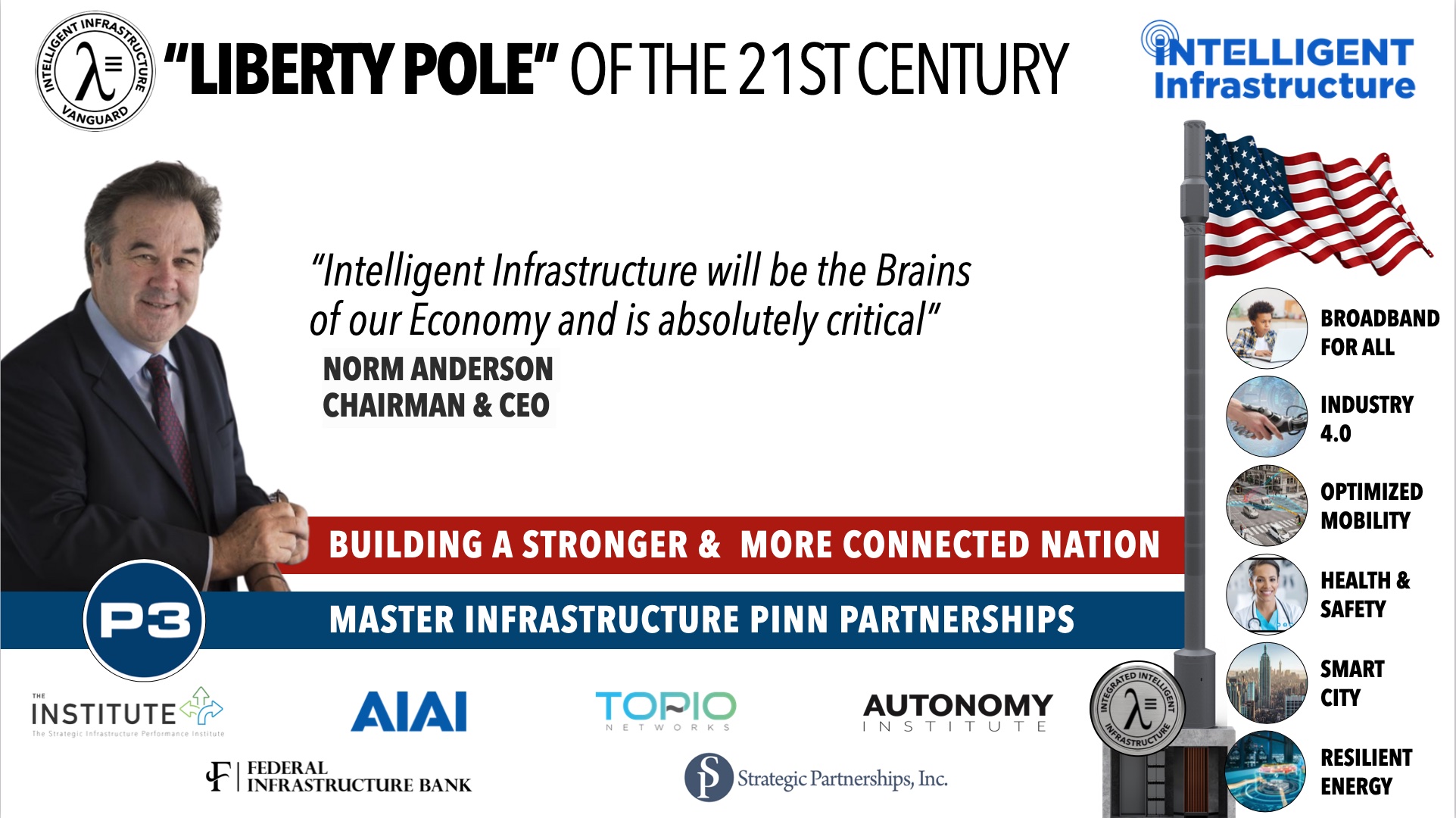INTELLIGENT INFRASTRUCTURE ECONOMIC ZONES
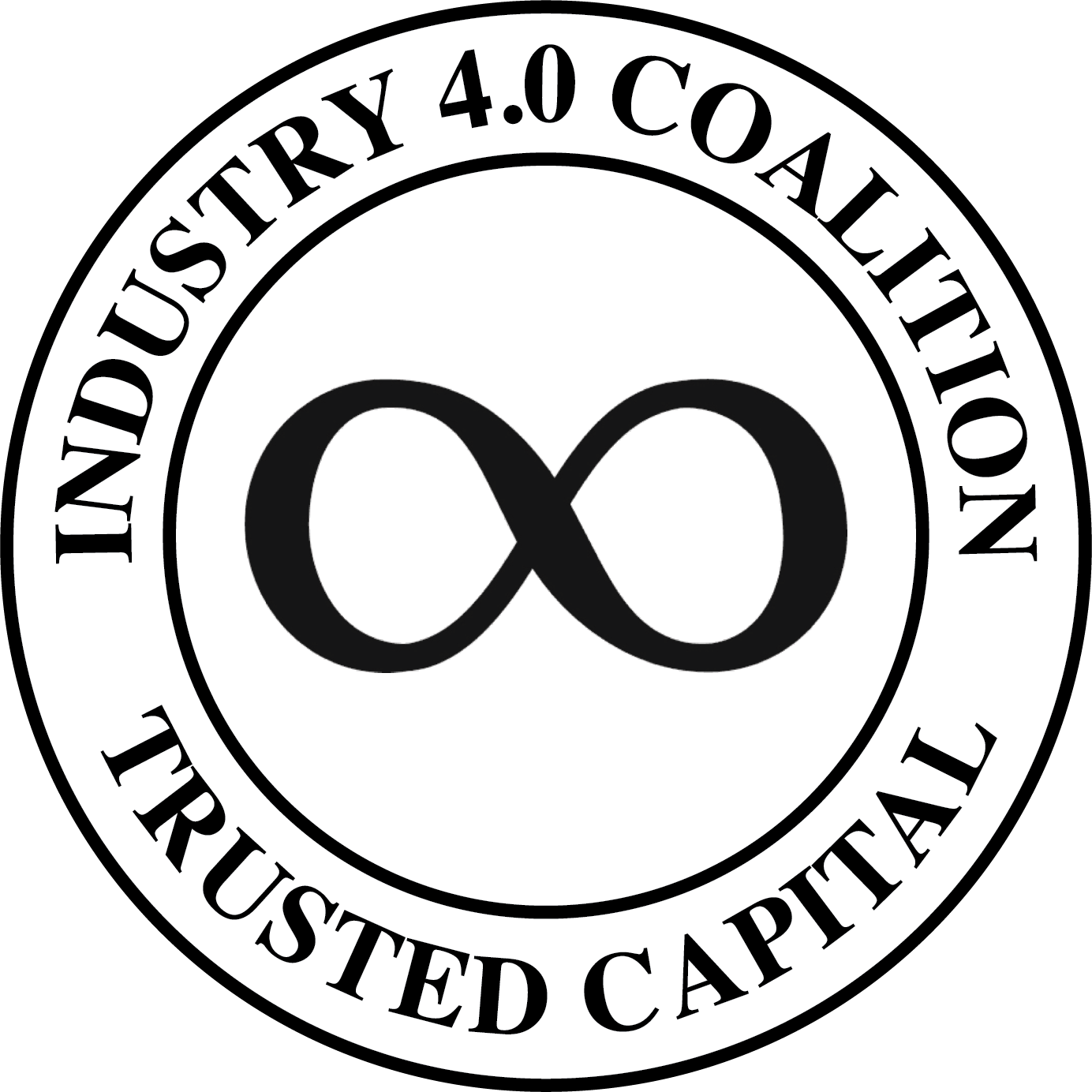
We are establishing an Industry 4.0 Coalition aligned with the United States DOD Trusted Capital program. It is critical to establish an investment capital foundation to support the new technologies, services, and manufacturing operations. Industry 4.0 will drive the next 100 years of innovation.
Building Stronger and More Connected Communities
Our nation is going back to Building infrastructure at scale. National sovereignty and global productivity will go to the nation that deploys the Intelligent Infrastructure enabling Industry 4.0. Unleashing the largest productivity boom in world history.
Norm Anderson, the Legendary Infrastructure Leader, said it best: “Intelligent Infrastructure depends on leadership, It will be the brains of our economy.”
For decades he pulled together leaders and visionaries to invigorate the buildout of the infrastructure for the 21st century. His passion has spawned an army to make his vision a reality. His book Vision: Our Strategic Infrastructure Roadmap Forward lays out a roadmap for the United States.
INFRASTRUCTURE IS OUR FIRST ORDER PRIORITY
Intelligent infrastructure will spark a national revival similar to the 1936 Rural Electrification and the 1956 Interstate Highways. Intelligent Infrastructure (the foundation of ARPA-I) goes well beyond transportation and will be the brains of our economy. Providing advanced city services, resilient and carbon-free economies, closing the technology divide, enabling autonomous systems, and most important; securing data for people, cities, and governments. Creating millions of new jobs and economic growth nationwide.
Intelligent infrastructure refers to the integration of advanced technologies, data analytics, and connectivity into traditional physical infrastructure systems in our communities, cities, states, and countries.

INTELLIGENT INFRASTRUCTURE – FOUNDATION OF INDUSTRY 4.0
Intelligent Infrastructure will Drive a National Revival
Enhanced transportation networks: Intelligent infrastructure will revolutionize transportation systems by incorporating technologies such as autonomous vehicles, smart traffic management, and real-time data analysis. This could lead to more efficient and safer transportation, reduced congestion, lower emissions, and increased productivity. Improved transportation networks can boost economic growth, create jobs, and facilitate the movement of goods and people across the country. Intelligent Infrastructure provides the “Street Smarts” that will save lives and provide massive economic returns. Without it, over the last two decades, we have seen 900,000 deaths, over 50 million injuries, and $10+ trillion in economic loss.
Smart cities and sustainable development: Intelligent infrastructure can enable the development of smart cities, where various aspects of urban life are connected and optimized for efficiency. Smart grids, intelligent buildings, and integrated public services can improve energy efficiency, reduce resource consumption, and enhance the quality of life for residents. By promoting sustainability and resilience, intelligent infrastructure can foster a renewed focus on environmental stewardship and sustainable development.
Economic competitiveness: By investing in intelligent infrastructure, nations can enhance their global economic competitiveness. Intelligent transportation networks, high-speed broadband connectivity, and smart logistics systems can attract businesses, stimulate innovation, and support entrepreneurship. A well-connected and technologically advanced infrastructure can attract investment, promote industries of the future (such as artificial intelligence, robotics, and clean energy), and generate new employment opportunities.
Improved public services: Intelligent infrastructure will transform the delivery of public services, including healthcare, education, public safety, and utilities. For example, telemedicine can extend healthcare access to remote areas, smart classrooms can enhance educational outcomes, and advanced emergency response systems can improve public safety. By leveraging technology and connectivity, intelligent infrastructure can create more inclusive and efficient public services for all citizens.
Data-driven decision-making: Intelligent infrastructure generates vast amounts of data that can be analyzed to drive informed decision-making. Data analytics can optimize the operation and maintenance of infrastructure, predict maintenance needs, and improve asset management. This enables proactive planning, cost savings, and better allocation of resources. By harnessing the power of data, intelligent infrastructure can unlock new efficiencies and drive evidence-based policymaking.
Artificial Intelligence(AI): AI can stimulate economic growth and innovation by fostering entrepreneurship, supporting advanced manufacturing, and driving digital transformation. AI-powered technologies enable businesses to automate processes, gain insights from data, and develop innovative products and services. AI can enable personalized services for residents regarding local events, services, and amenities. Moreover, AI can engage with citizens, answer queries, and provide information, enhancing citizen engagement and satisfaction.
Intelligent and Autonomous Systems: As the United States moves to reestablish manufacturing leadership our productivity is dependent on our ability to deploy Intelligent Infrastructure and automated/autonomous systems outside the factory. It is also critical to do this by empowering the individual and family unit which is a key foundation of the United States. Industry 4.0 is dependent on millions of new diverse jobs and every job has a critical impact on society. In the past, we had to consolidate and build commercial operations to increase production. Now we can take automated and autonomous systems out of the factories and integrate them into society at the same time of increasing production output.
Realizing the full potential of Intelligent Infrastructure requires significant investment, collaboration among stakeholders, and careful consideration of privacy, security, and ethical concerns. Additionally, equitable access to Intelligent Infrastructure and addressing the digital divide are essential to ensure that the benefits of national revival are distributed inclusively. The Autonomy Institute has developed the coalition, the plans, the leadership, and the investment structures to ensure success.
Time to Build the Infrastructure for the Next 100 Years.
“The great economic revolutions in history are infrastructure revolutions”
INTELLIGENT INFRASTRUCTURE ECONOMIC ZONES
Intelligent Infrastructure is a national program being executed across our nation. Intelligent Infrastructure will be the brains of our economy enabling advanced city services, resilient grids, autonomous systems, and most important; securing data for people, cities, and governments.
Intelligent Infrastructure Economic Zones have the potential to revive cities and communities across the United States in several ways:
Job creation and economic growth: Intelligent Infrastructure Economic Zones can attract businesses, entrepreneurs, and investors, leading to job creation and economic growth. These zones can provide a fertile ground for emerging industries, such as advanced manufacturing, clean energy, and technology-driven sectors. The integration of intelligent infrastructure technologies can drive innovation, productivity, and competitiveness, revitalizing local economies and providing employment opportunities.
Urban revitalization and redevelopment: Intelligent Infrastructure Economic Zones can serve as catalysts for urban revitalization. By transforming underutilized or distressed areas into technology-driven hubs, these zones can attract investment, stimulate urban renewal, and promote the development of smart and sustainable cities. By leveraging intelligent infrastructure, communities can reimagine and redevelop their urban landscapes, creating vibrant and livable spaces for residents and businesses.
Enhanced connectivity and accessibility: Intelligent Infrastructure Economic Zones can improve connectivity within and between cities and communities. By deploying high-speed broadband networks, smart transportation systems, and digital infrastructure, these zones can bridge the digital divide and ensure equitable access to information and opportunities. Improved connectivity enhances communication, education, healthcare, and access to markets, driving economic development and improving the quality of life for residents.
Innovation and entrepreneurship: Intelligent Infrastructure Economic Zones foster innovation and entrepreneurship by creating environments that support collaboration, knowledge sharing, and experimentation. These zones can bring together researchers, startups, established companies, and educational institutions, promoting the exchange of ideas, fostering innovation clusters, and nurturing a culture of entrepreneurship. By providing access to resources, mentorship, and networking opportunities, these zones can empower individuals and businesses to create and scale innovative solutions.
Sustainable and resilient communities: Intelligent Infrastructure Economic Zones can prioritize sustainability and resilience in their development. By incorporating renewable energy sources, energy-efficient buildings, smart grids, and climate-resilient infrastructure, these zones can reduce environmental impact, mitigate climate change risks, and promote sustainable development practices. This not only contributes to environmental conservation but also enhances community well-being and attracts businesses that value sustainability.
Community engagement and participation: Intelligent Infrastructure Economic Zones provide an opportunity for community engagement and participation in the planning and development processes. By involving residents, local organizations, and community leaders, these zones can ensure that the needs and aspirations of the community are considered. Engaging with stakeholders can lead to inclusive decision-making, address social equity concerns, and create a sense of ownership, ultimately fostering stronger and more cohesive communities. To ensure the success of Intelligent Infrastructure Economic Zones, it’s crucial to establish supportive policies, encourage public-private partnerships, and prioritize long-term sustainability. Additionally, addressing potential challenges related to workforce development, affordability, and equitable access to resources and opportunities is vital to ensure that the benefits of these zones are shared widely across cities and communities.
INFRASTRUCTURE IS COMMUNITY
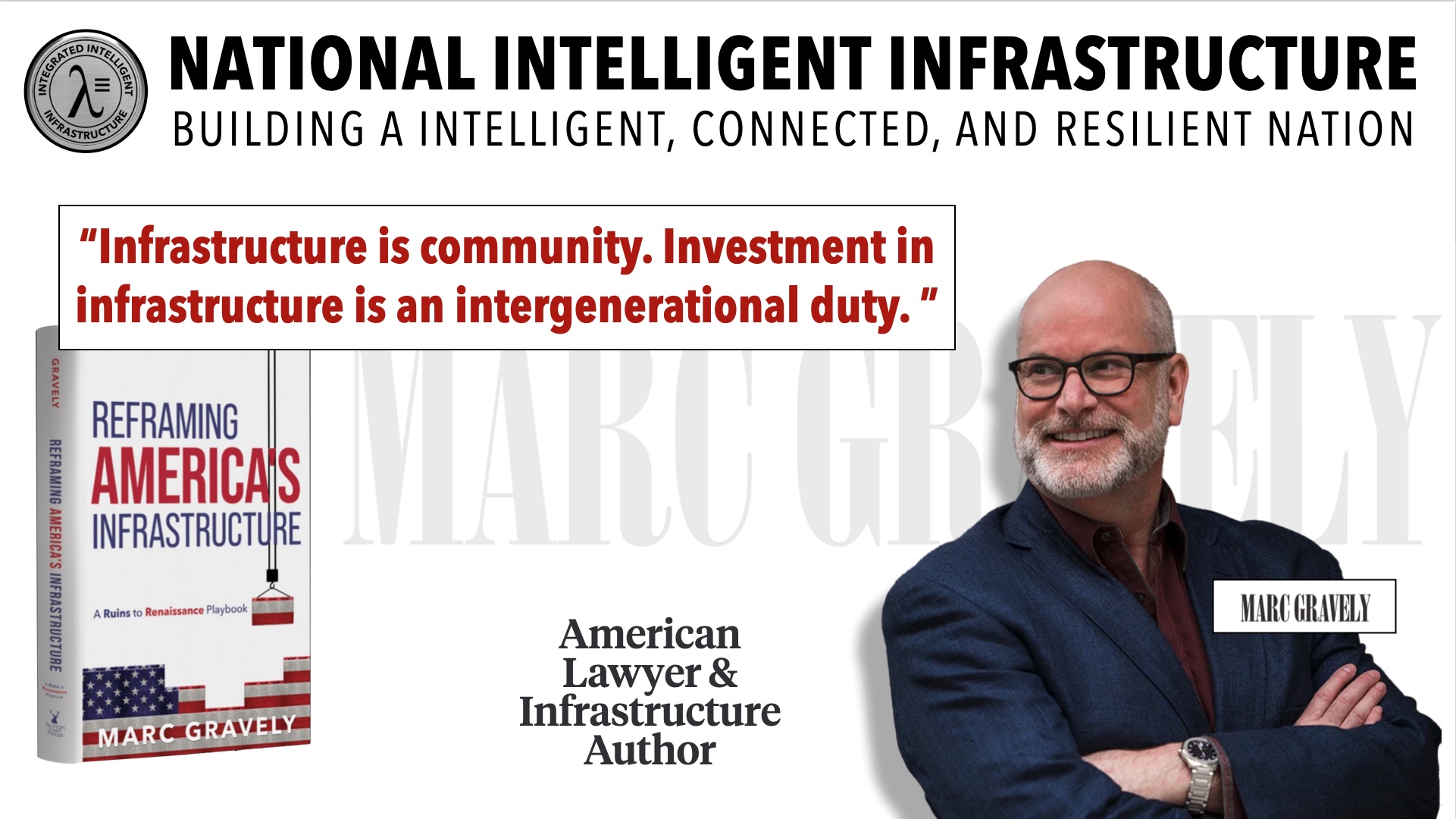
Reframing Americas Infrastructure by Marc Gravely highlights the need for an Infrastructure Revival.
“Infrastructure is community. Investment in infrastructure is an intergenerational duty.”
Intelligent Establishing a North Star for Intelligent Infrastructure
Establishing a North Star for the buildout of Intelligent Infrastructure is key. JFK stated we will put a man on the moon which stimulated engineers, scientists, investors, entrepreneurs, and manufacturers to solve the hard challenges that stood in the way of reaching that national North Star. Eisenhower established a North Star for Interstate Highways. He knew it would require new material sciences, new machinery, new technologies, new community engagement, and new investment models; but he focused on the North Star. He just lead by saying WE HAVE TO BUILD THEM. Innovation and progress are not driven by POC and pilots. Intelligent Infrastructure is the North Star to launch the national buildout that will enable 21st-century solutions.
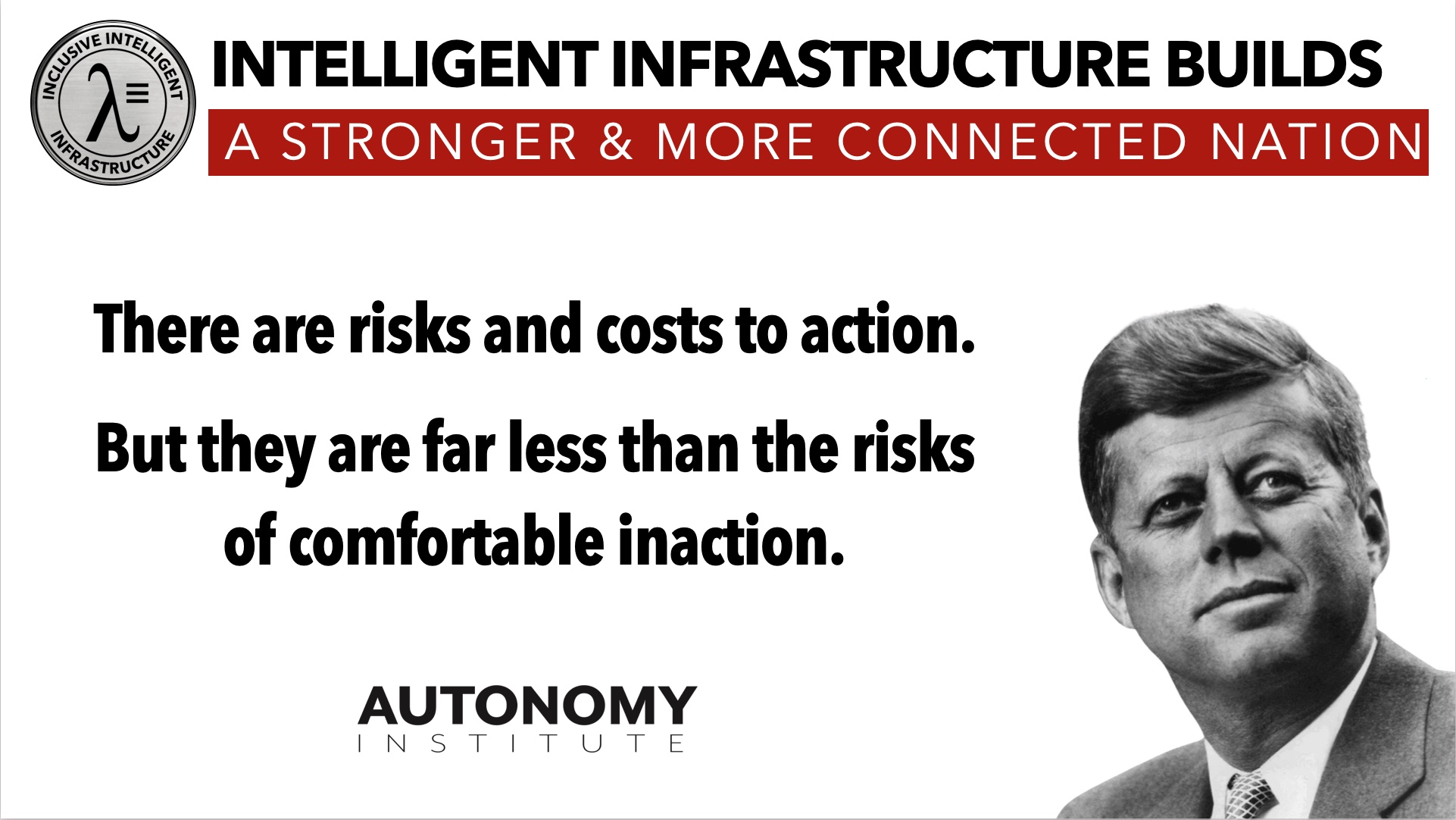
“There are risks and costs to action. But they are far less than the risks of comfortable inaction.” JFK

THE CONTINUUM OF INNOVATION CAPITAL
The Continuum of Investment Capital
The Autonomy Institute has been working with capital market partners to develop innovative financing vehicles for regional innovation ecosystems.
-
Some of the execution models include:
-
Integrated Intelligent Infrastructure Trust (I3T)
-
Master Infrastructure PINN Partnership (MIPP)
-
Autonomous Infrastructure Economic Zones (AI-EZ)
-
Intelligent Infrastructure for Advanced Services (IIAS)
-
Autonomous Mobility Districts (AMD)
-
Distributed Work Centers (DWC)
Intelligent Infrastructure opens the door to financial innovations for this new infrastructure. Why is this important? A private sector company designs its capital structure with a mixture of capital sources, ranging from debt to equity. This capital structure provides the financial resources that flow through the enterprise to enable the firm to grow. In the same way, a regional innovation system needs a diverse, balanced capital structure to be sustainable. To this point, despite having the most efficient capital markets in the world, we have not approached the financing of a regional innovation system with the same logic that we apply to firms. The Intelligent Infrastructure Economic Zones will enable innovations in capital markets to finance I3 investments. The development of standards and protocols will enable i3 investments to access large pools of capital. The Autonomy Institute is working on innovations to access these capital pools.
Well-defined markets for infrastructure investment rely on debt financing, a form of capital that relies on an underlying cash flow. Local governments rely on debt financing to generate the capital needed to build infrastructure: roads, water systems, power plants, and convention centers, for example. The holders of the debt look to the ongoing revenues from taxation to generate the cash needed to repay the debt. This market consists largely of municipal bonds issued by state and local governments, school districts, and other public entities. The market is large: about $3.8 trillion. Long-term debt finance also underwrites most real estate investments. Real Estate Investment Trusts (REITs), for example, finance income-generating real estate. They invest in many different types of real estate: apartment buildings, cell towers, data centers, hotels, medical facilities, offices, retail centers, and warehouses. The total value of the commercial real estate market is about $16 trillion. Both of these sources of long-term capital — municipal bonds issued by governments and REITs formed as private sector companies — will provide the financing needed for investing in Intelligent Infrastructure.
Stock markets enable financing vehicles like REITs to access large pools of capital. A master limited partnership (MLP) provides yet another vehicle that can be designed to support Intelligent Infrastructure. An MLP trades on a stock exchange and combines the tax benefits of a private partnership with the liquidity of a publicly-traded company. A master limited partnership trades on national exchanges. MLPs rely on stable cash flows. The partnership agreement requires stable distributions of cash to investors. Because MLPs pass investment return directly through to their investors, they pay no taxes at the corporate level. The MLP market is much smaller — about 460 billion — but this promising structure is another example of how large-scale capital can flow into the financing of Intelligent Infrastructure.
The analogy of how Intelligent Infrastructure deployment can accelerate innovation is comparing it to Interstate Highways. Infrastructure investors funded the construction of the highways, while innovation investors are funding the development of future automobiles, advanced supply chains, manufacturing facilities, e-tolling systems, navigation tools, and truck stops.
CONTINUUM OF INNOVATION CAPITAL PARTNERS
INTELLIGENT ECONOMIC ZONES & MIPP MODEL: Night Keyes, a strategic advisor to the Autonomy Institute, has worked extensively with infrastructure capital investors, law firms, public infrastructure advisors, financial firms, and accountants. All in efforts to align innovation capital with infrastructure capital, leveraging non-dilutive funds, economic development zones, and new policy/tax code on capital gains. More on MIPP and P3s below.
INFRASTRUCTURE: The Federal Infrastructure Bank (William T. Nolan) has been filed and will mobilize $billions in private “infrastructure” capital. The FIB will help rebuild America and strengthen our economic competitiveness with the rest of the world. The FIB will support the national deployment of Intelligent Infrastructure and compete with China’s Belt and Road Initiative and their MCF. Industry 4.0 VICTORY BONDs.
VENTURE: Joe Milam at AngelSpan, Inc. is leading the way with 21st Century Venture & Legacy Funds. A state-of-the-art venture fund model to support a broad portfolio of innovative companies in the Intelligent Infrastructure Economic Zone, supporting Seed to B rounds of equity financing. Better Information. Better Process, Better Outcomes.
COMMERCIALIZATION: John Cowan is building Venture Studios on top of the Intelligent Infrastructure Economy Zones. Next Wave Partners: https://lnkd.in/gYgyb4pm. Venture studios are another promising capital market innovation that can apply to I3. The venture studio model focuses on financing startups from the ground up. Venture studios are designed to compress time, iterate quickly, and scale faster. The model uses a pool of resources — capital, management processes, and talent — to accelerate the formation of start-up companies. Outside investors provide capital to the studio.
COMMUNITY: Ed Morrison at Strategic Doing Institute is building at the Intersection of the Civic & Market Economy. Providing a reliable approach for designing and guiding complex collaborations to link, leverage and align assets. Zebra, the world’s first Innovation Resource Management Platform is an open-source digital protocol to speed region-wide collaboration. Highly interconnected with Michael Shear, Strategic Office Networks, LLC.
INVESTORS: There is now billions of investment capital ready to underwrite Microgrids, smart city, broadband, electrification of mobility, vision zero, secure supply chains, and Intelligent Infrastructure.
Infrastructure investors with Intelligent Infrastructure Funds include Goldman Sachs, Morgan Stanley, Brookfield Asset Management, Macquarie Group, KKR, CPP Investments | Investissements RPC, JPMorgan Chase & Co., 26North.
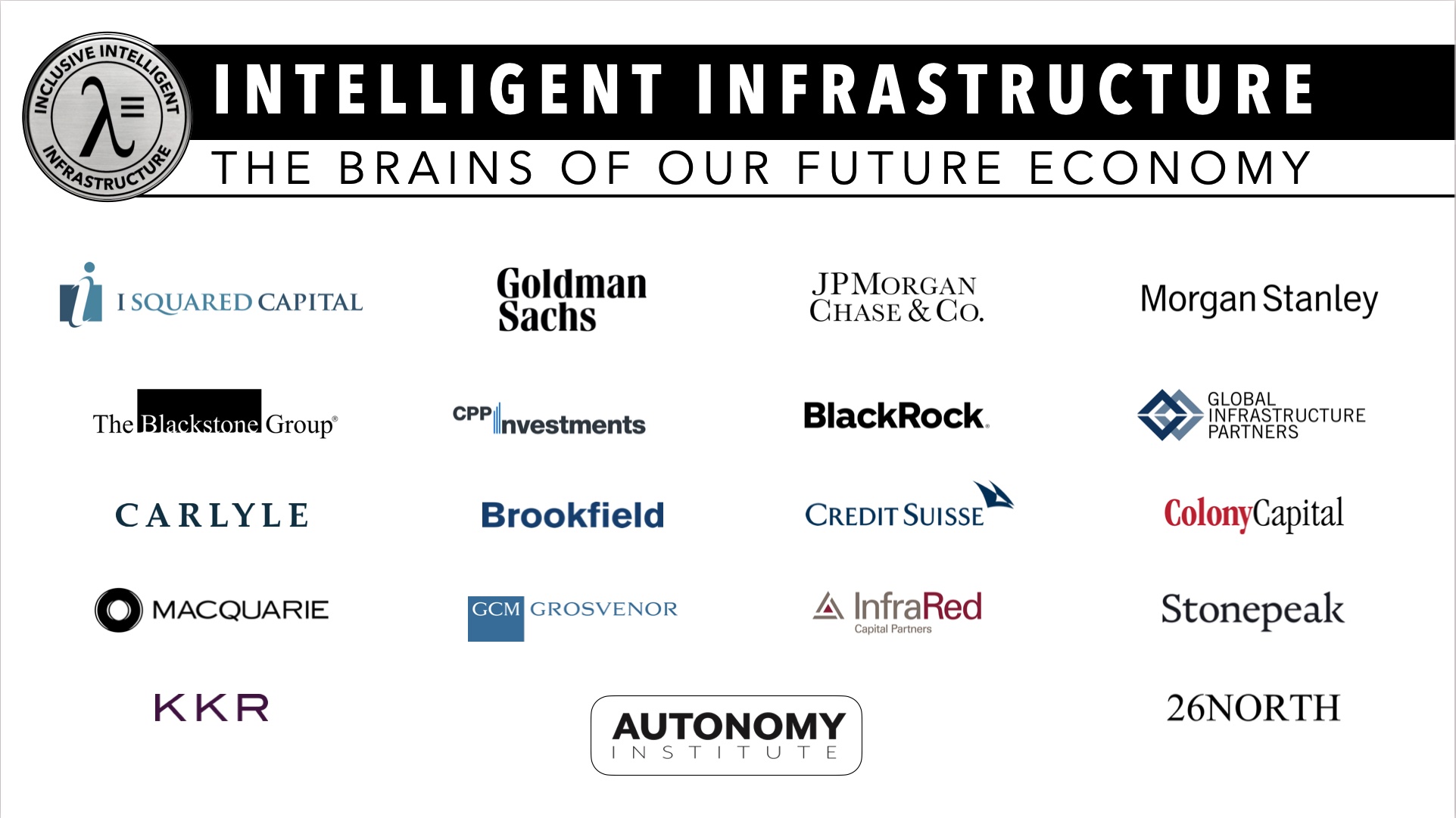
INTELLIGENT INFRASTRUCTURE AND THE MIPP
INTELLIGENT ECONOMIC ZONES & MIPP MODEL: The Master Infrastructure PINN Partnership (MIPP) is a financial structure that combines a master-limited partnership (MLP) with a real estate investment trust (REIT) business model and is known as an “MLP-REIT hybrid.” This structure allows a company to raise capital from investors in a similar way to an MLP, by issuing units that pay out distributions, while also enjoying the tax benefits of a REIT, which is required to distribute at least 90% of its taxable income to shareholders. This structure can be particularly beneficial for companies that own and operate real estate assets, such as pipelines, storage facilities, and now Intelligent Infrastructure, as it allows them to access capital markets while also providing a steady stream of income to investors.
MIPP & IIEZ MODEL TREATS DATA AS AN ASSET
Intelligent Infrastructure will enable new applications and services based on Data. Data is often referred to as the “new oil” because, like oil, it is a valuable resource that is in high demand, and can be used to power a wide range of applications and services. The concept of data as the “new oil” suggests that the way data is collected, stored, and exchanged will be similar to the way oil is extracted, refined, and transported.
One potential business model to support data exchanges, intelligent infrastructure, and all the new applications and services is the creation of Sovereign Data Exchanges, which would function similarly to stock exchanges or commodity exchanges. These marketplaces would allow organizations to buy and sell data, with prices determined by supply and demand.
Another potential business model is creating a data infrastructure company that is similar to a utility company, which would be responsible for maintaining and operating the infrastructure that is needed to collect, store, and exchange data. This company would be responsible for the maintenance, security, and privacy of data, and would charge customers for access to the infrastructure and the services that it provides.
Additionally, companies could also be created to offer new data-driven products and services, such as artificial intelligence, machine learning, and big data analytics, which will help to unlock the value of the data.
It’s worth noting that these are only some examples of potential business models for data, and the rise of new technologies and the evolution of regulations will likely create new opportunities for companies to monetize data in the future.
The regulatory and legal frameworks are under development for this new financial structure. The MIPP model will treat data as a type of real property asset. These Data Exchange structures will operate within the Intelligent Infrastructure Economic Zone as a hybrid of a master limited partnership (MLP) and a real estate investment trust (REIT).
IIEZ & SOVEREIGN DATA EXCHANGES
A Private-Public Partnership (PPP) model is a viable organizational structure for a sovereign data exchange that serves a specific city or community. This model can bring together the resources and expertise of both the private and public sectors to achieve a common goal, which in this case would be to create a secure and efficient data exchange for the community.
The private sector would bring in its expertise in data management, technology, and business operations, while the public sector would provide oversight and ensure compliance with regulations, privacy, and security laws.
Additionally, PPPs can also provide a way for the government to leverage private sector funding and expertise to develop and operate data exchange infrastructure. This can help to minimize the financial burden on the government and allow for the project to be completed more quickly and efficiently.
It’s worth noting that the PPP is not the only organizational structure that could be used for sovereign data exchanges, and the choice of structure will depend on the specific needs of the community, the legal and regulatory environment, and the availability of funding. Other organizational structures such as a non-profit, a co-op, or a government-owned corporation could be considered as well.
AUTONOMY INSTITUTE
The Autonomy Institute(501c3) is a government, industry, academia, and public alliance focused on accelerating the “Path to Commerce” for Intelligent Infrastructure and autonomous systems. Over 200 organizations are engaged and supporting the policies, markets, jobs, and community benefits of autonomy to foster social and economic transformation.
Intelligent and Autonomous Infrastructure is the equivalent of the Eisenhower Interstate Highways. The Autonomy Institute collaborates with large infrastructure investors on the creation of $100+ million Public-Private Partnership programs. The intelligent infrastructure enables the rapid and expansive deployment of rural broadband, NextG, edge computing, intelligent transportation systems, APNT, and smart grid devices. This infrastructure has substantial benefits to cities by eliminating the digital divide and preparing communities for Industry 4.0 solutions. The national deployment of this infrastructure will create millions of new jobs and generate billions in economic growth.
The Autonomy Institute has developed an “Autonomy Commerce Act” and an “All-Up” Autonomy program within the United States.

